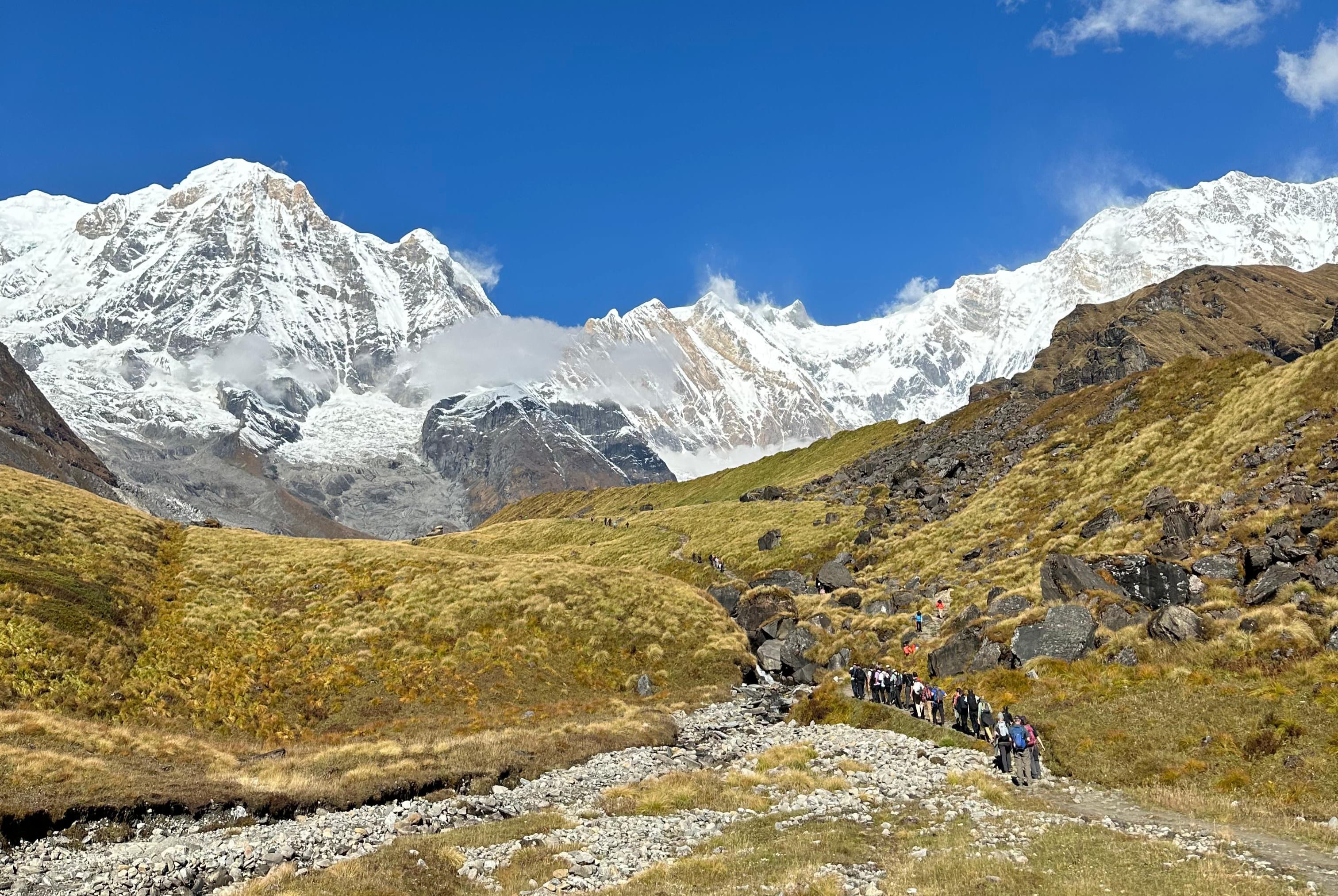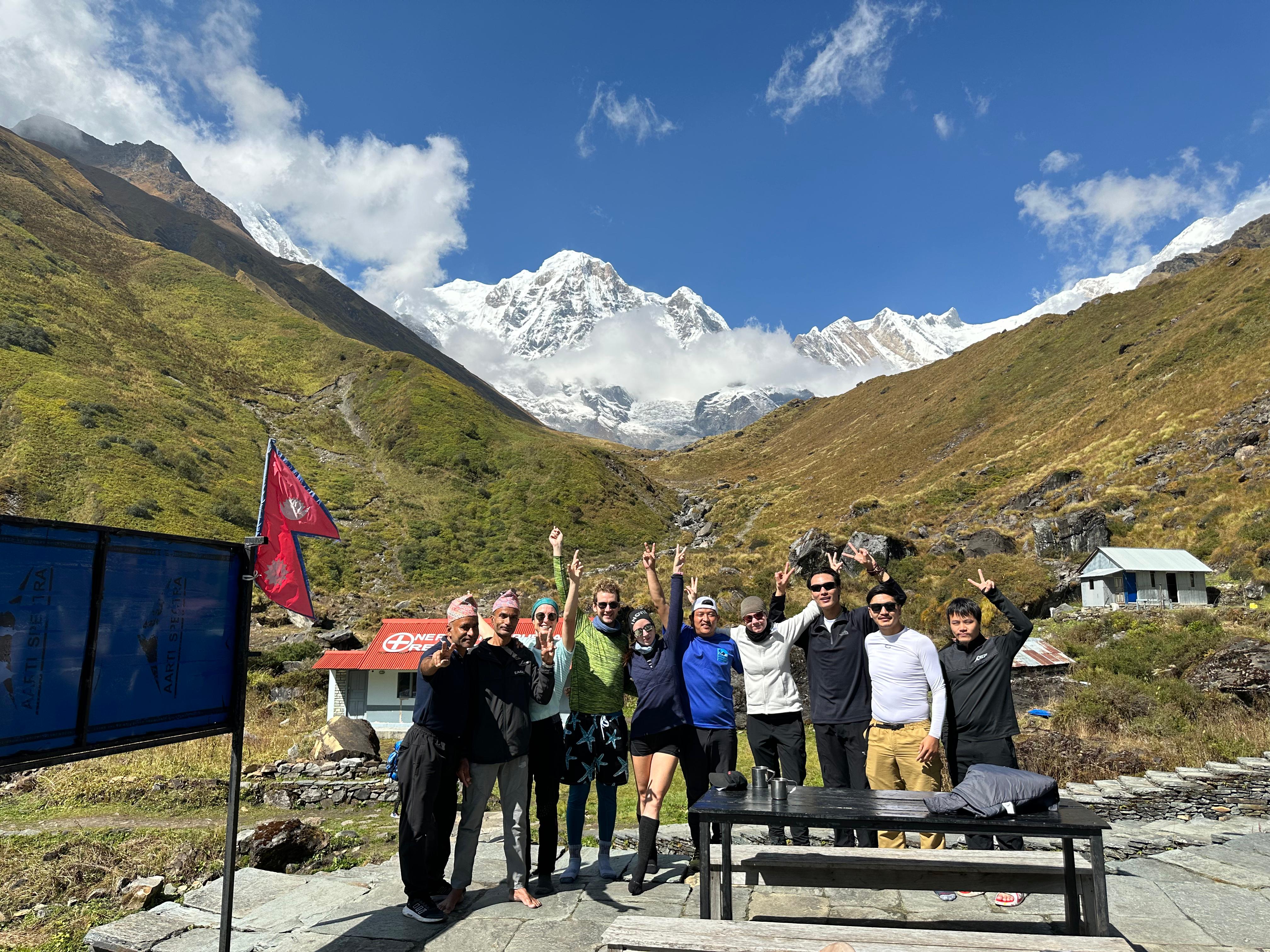Why is Annapurna Base Camp Famous? Nepal’s Top Trekking Destination
Have you ever wondered why Annapurna Base Camp is famous? Located in the heart of Nepal, it is one of those treks everyone wants to do. From panoramic views to varied landscapes and culture, there is no question why the ABC trek remains one of the most coveted in the world. The Annapurna Base Camp height and its outstanding beauty have made this journey popular, especially for all kinds of trekkers.
Why does the ABC trek stand out?
Stunning Mountain Views: Offering unparalleled views of some of the highest and most majestic peaks in the world, such as Annapurna I, Machapuchare, commonly referred to as Fishtail, and Dhaulagiri, the visual experience is uniquely different.
Proximity to Annapurna Massif: The ABC trek brings one closer than any other trek to the heart of the Annapurna Massif, offering closeness to the mountains from all directions as one goes up.
Diverse Terrain: The route's terrain varies, ranging from lush forests and terraced fields to rocky landscapes and glacial moraines, making every day different and exciting.
Impressive Sunrise Views: Early in the morning, the golden sunrise of the snow-capped peaks forms an impressive view that remains unforgettable throughout one's life during the trek.
The Annapurna Sanctuary: The trek goes to the Annapurna Sanctuary, a natural amphitheater surrounded by the world's highest peaks. The surrounding environment is unique and provides a peaceful setting, making it a spiritual retreat for trekkers.
Wildlife and Flora: The trek boasts an immensely wonderful variety of flora and fauna while negotiating the altitude, from subtropical plants and alpine flowers to wildlife such as the Himalayan tahr and several species of birds.
Unparalleled Natural Beauty: A Visual Delight

Majestic mountain views: Encounter the Annapurna Massif
The trek offers stunning views from the front-row seats of some of the highest peaks in the world: Annapurna I, Machapuchare, and Dhaulagiri.
Most of all, your trek approaches the towering Annapurna Massif closer and closer as you rise in altitude, offering an immersive view that not many other treks can.
After all, the prospects from Base Camp at 4,130 meters are breathtaking, panoramic views that make the effort worth it.
The golden hues of these peaks during dawn and dusk create unforgettable moments for trekkers and photographers alike.
The huge scale of the mountains, with their snow-capped beauty, creates a humbling and awe-inspiring experience that is forever engraved in the memories of trekkers.
Recommendation Read: Tips For Trekking To Annapurna Base Camp
Diverse landscapes: From lush forests to snowy peaks
Trekking through lush subtropical forests, terraced fields, alpine meadows, and snow-covered terrain provides various landscapes.
As you go upwards, the Rhododendron forests become a riot of color, and high-altitude flowers add their special beauty.
It goes from green valleys to rocky, snow-dusted peaks higher up, so the landscape changes are visually interesting at every turn.
There are many crystal streams and cascading waterfalls along the way that add to the beauty of nature.
Spectacular views greet the trekker at each turn on ABC's fantastic transition from lower to high altitudes.
Featured Trip: 14-Days NAR-PHU Trek
A photographer's paradise
ABC is a dream destination for any photographer. This trek offers innumerable opportunities to capture a shot, from the vibrant greenery of the lower regions to the snow-laden peaks. The interplay of light and shade on mountains, colored flowers, and serene landscapes make this trek perfect for photography lovers.
Be it the golden hues of the sunrise over Annapurna or the quiet beauty of the local villages, every part of the trek is picture-perfect. For a nature photographer, the trek is absolutely a feast. You can know more about it by reading our blog best time to visit Annapurna Base Camp.
Rich Cultural Experience
The culture of the Gurung and Magar people
The ABC trek provides great insight into the culture of two dominant ethnic groups, the Gurung and Magar people. Cities like Ghandruk and Chomrong retain traditional lifestyles with stone houses, terracing fields, and lively festivals. The Gurung culture is very much wedded to the history of this region through bravery as soldiers, while the Magar people are steeped in the hills.
These two groups, famous for their colorful dresses, dances, and folk music, add a cultural touch to the trek. The people are warm and love telling stories of themselves and their traditions to the trekkers, which enriches the journey.
Experience local hospitality
These trekking villages in ABC offer the best chance to savor local hospitality firsthand. Many stay in homestays where local families offer modest, delicious meals and comfortable full-board stays, making visitors feel at home. Dal bhat, momo, and seasonal vegetables are also served with a warm and generous touch, reflecting the region's culinary traditions.
Locals are very friendly and ready to express their culture, tell stories, and share customs with trekkers. Quaint teahouses dot the route, and rest houses where one can stop to munch on local delicacies and learn more about the daily lives of the people inhabiting these villages, thus enriching the trek experience.
Accommodation on Annapurna Base Camp Trek
What Difficulty To Expect on the Way to Base Camp
- Moderate Difficulty Level
- Varied Terrain
- Gradual Ascent with Challenging Sections
- Altitude Challenges
- Long Daily Walks
- Mental and Physical Preparation Required
- Rapid Weather Changes
Know about the difficulty between Annapurna Base Camp and Annapurna Circuit.
Safety and Preparation: Tips for a Smooth Adventure
- Gradual Ascent and Acclimatization
- Essential Gear for the Trek
- Hydration and Nutrition
- The Importance of a Guide or Trekking Agency
- Listening to Your Body
- Preparing for Varying Weather Conditions
- Fitness Level Considerations
- Staying Informed About the Trail and Terrain
The Range of Trekking Options: Short Treks to Extended Routes
Short Treks
Easy Approach to Beautiful Sceneries: Short treks offer lesser altitude elevation gains, giving easy access to beautiful mountain scenery within a short period.
Ideal for Beginners: Perfect for inexperienced trekkers or those who have limited time but wish to see some of the beauty of Annapurna.
Perfect for Limited Time: These are perfect for those in a rush, allowing trekkers to at least experience a portion of the Annapurna area in days.
Less Physically Demanding: Short treks generally include fewer altitude gains and are considerably softer than long ones, which is easier for those not up for a strenuous challenge.
Easy Trekking Routes: Routes such as Ghorepani Poon Hill offer shorter trekking days and less challenging terrain.
Extended Routes
Deep Exploration of the Himalayas: Longer treks like the ABC trek are very good for deep exposure to the Annapurna region.
Physical Fitness and Adventure: Extended treks are more physically demanding, so they are ideal for experienced trekkers seeking a worthwhile challenge.
More Acclimatization Time: These treks offer extra time for acclimatization, which is necessary for safely traversing areas of high altitude.
Diverse Landscapes: Longer routes travel through different landscapes, from the subtropical forests and alpine meadows to the glacial zones of the Himalayas.
Cultural Interaction-Enriched Experience: Extended routes allow more time for cultural interactions with the local communities, thus allowing for a far richer trekking experience.
Best Time to Visit: How the Seasons Affect Your Experience
1. Spring (March to May)
Spring represents one of the best times for trekking around the Annapurna region. The temperature is mild during this season, making trekking comfortable. In lower elevations, the temperature ranges from 10°C to 20°C (50°F to 68°F) during daytime; during night, it may get down to approximately 5°C to 10°C (41°F to 50°F).
This higher Annapurna base camp altitude will be cold; it usually ranges from -5°C to 5°C, from 23° to 41° Fahrenheit, but generally tolerable for most trekkers. The weather is stable with clear skies, and the beautiful rhododendron blooms add beauty to the trails.
2. Autumn (September to November)
This is the peak season for trekking in ABC. The temperatures are pleasant and appropriate for trekking. They fluctuate between daytime and nighttime, starting at 12°C to 20°C [54°F to 68°F] during the day and falling to as low as 5°C to 10°C in the lower altitudes.
Daytime temperatures rise to 5°C-12°C during the time of higher altitudes, which may drop down to -5°C to 0°C at night at ABC. Clear and dry, with perfect trekking conditions and ideal views of the mountain peaks.
3. Winter (December to February)
Winter brings colder temperatures, especially at higher elevations; thus, trekking is more problematic, though it offers a chance to those who want complete solitude. In the lower altitudes, daytime temperatures can go from 5°C to 10°C (41°F to 50°F), while nighttime temperatures can drop to -5°C to 0°C (23°F to 32°F).
It can also get as low as -5°C to 5°C or 23°F to 41°F at higher altitudes during the day, though it usually drops to -10°C to -15°C or 14°F to 5°F at night. This temperature may go lower even at ABC. Of course, there is a lot of snow at high altitudes, and it is very cold, so trekkers must be prepared for severe conditions.
Essential Trekking Preparation For Nepal
4. Summer/Monsoon (June to August)
This is considered the worst season for trekking in the Annapurna region. The rainfall is heavy during this year, while temperatures vary between altitudes. The temperature during the daytime at lower altitudes could range up to 15° to 25°C (59° to 77°F), while during the night, it could get as low as 10° to 15°C (50° to 59°F).
The higher altitudes receive temperatures from 5° to -10°C throughout the day and -5°-5°C at night. Though lush greenery adds much beauty to the trek, the constant rain makes the trails slippery and prone to landslides. Hence, this will also affect your general trekking conditions.
Featured Trip: Annapurna Circuit Trek
Conclusion
Annapurna Base Camp is famous for its incomparable mountain scenery, diversified culture, and great trek. Whether drawn to the splendor of the massive Annapurna Massif or the rich culture of the local people, this trek has something for everyone. Spring and autumn are the best times of the year, while trekking styles suit all levels.
With good preparation and timing, the ABC Trek will leave you with lifelong memories. Dolpo Caravan Treks' various skills make your journey safe, comfortable, and full of remarkable experiences, ideal for guiding your adventure into ABC.
FAQs
What is the best time to trek to ABC?
The best time to trek to ABC is spring, from March to May, and autumn, from September to November. These seasons have mild temperatures, clear skies, and stable weather conditions, ideal for trekking. The trails are less muddy, and the mountain views are at their most spectacular during these months.
How difficult is the ABC trek?
The ABC trek is graded as moderately difficult, requiring a basic fitness level among trekkers. While the trek involves several days of uphill walking and a steady ascent, it does not require advanced technical skills. Proper acclimatization and a gradual pace are of prime importance in avoiding altitude sickness for an enjoyable experience.
What is the Annapurna base camp trek cost?
The Annapurna base camp trek cost will vary according to your trek package, time, and the service included. This may range from $500 to $1,200, including permits, guides and porters, accommodation, and meals. Other costs that may add up are personal gear, tips, and optional excursions.
What is the altitude of Annapurna Base Camp?
Annapurna Base Camp is at an elevation of 4,130 meters or 13,550 feet. It is reached by a gradual increase through different altitudes; thus, necessary prevention against altitude sickness should be considered. Acclimatization at key points on the trek will help ensure a safe and comfortable journey.
Is it safe to trek to ABC?
ABC is generally a very safe trek for trekkers because the trail conditions are good, and there are enough teahouses and rest stops on the way. To avoid altitude sickness, trekkers must be properly equipped with proper equipment, adequate hydration, and proper acclimatization. It is highly recommended that a guide or porter be hired for safety and support reasons.
Why is Annapurna Base Camp famous in Nepal?
Annapurna Base Camp attracts thousands with its beauty, variety in landscape, and panorama of the Annapurna mountain range. It offers trekkers a unique combination of high-altitude trekking, cultural experiences, and proximity to one of the most breathtaking mountain views in the world. Moreover, the base camp is considered a gate toward some of Nepal's most iconic peaks.


Leave Your Comment